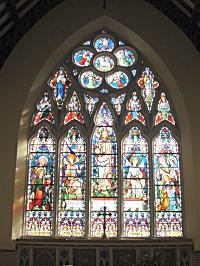Location
The memorial is on the great East Window.

Jacob Owen was born on 28 July 1778 in Llanfihangel, Montgomeryshire, the son of Jacob Owen, civil engineer, and his wife, Margaret Ellis. After being educated at a school in Monmouth, he was apprenticed to William Underhill of Tipton, Staffordshire, a canal engineer, whose daughter Mary (1781–1858) he married in 1798. They had seventeen children, thirteen of whom survived childhood. He joined the Royal Engineers' department of the Board of Ordnance in 1805 and was promoted to full clerk of works in the following year. Most of his career in the Ordnance was spent in Portsmouth. In 1831 Owen moved to Dublin as engineer and architect to the new board of works, a post which he was to hold until his retirement in 1856, at the age of seventy-seven. In Portsmouth he was assisted in his official duties by his brother John (d. 1867) and in private practice by his son Thomas Ellis Owen (1804–1862), who had trained as an architect in London.
Jacob's sons also included Jeremiah (1802–1850), who became a metallurgist to the Admiralty and store receiver at Woolwich Dockyard whilst other sons joined their father in the board of works, where critics perceived a dynasty in the making: William Henshaw Owen (b. 1813) was the board's engineer in Limerick; Henry (b. 1815) was his father's pupil and assistant before becoming in 1841 surveyor for Queen's county; while James Higgins Owen (b. 1822), who was made a clerk of works in 1849, succeeded his father as architect to the board in 1856. One of Jacob Owen's pupils, Charles Lanyon, who received a county surveyorship in 1835, married his daughter Elizabeth Helen in 1837.
Most of Owen's public commissions were in Dublin, where his earliest work at Dublin Castle was a block of castellated stables (1833); he subsequently remodelled the state apartments and other buildings there. Owen also carried out private commissions, including work for other departments such as the Dublin Metropolitan Police and the board of national education.
Owen was described as short, burly, and balding, with a florid complexion. His brusque manner, family favouritism, and dominance of Irish public works architecture brought him enemies. While there were several allegations of impropriety, none was proven. He was an investor in his son Thomas's developments in Southsea, where he moved from Dublin in 1867 with his second wife, Elizabeth Donnet Fry, widow of Captain John Fry. In 1864 he was a founder, with his son James, of the Irish Civil Service Building Society. He was an early fellow and vice-president (1849–67) of the Royal Institute of the Architects of Ireland.
Owen died at Tipton, Staffordshire, on 29 October 1870, and was buried in Mount Jerome cemetery, Dublin. His second wife predeceased him by five months.
[Extracted from a short article in the Oxford Dictionary of National Biography written by Bertha Porter, rev. Frederick O'Dwyer]
